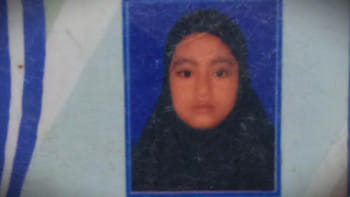Bring Back Our Girls

When television presenter Sabina Nipa went missing from Gulshan not two weeks ago, the nation had barely recovered from the brutal killing of Sohagi Jahan Tonu. Yet, Nipa's disappearance has already been overshadowed by the sensational suicide of a young girl called Sabira (21).
And this too, shall pass.
Allegedly, Sabira Hossain posted a video on social media where she talked about her boyfriend, their relationship and ensuing frustrations. She then wrote a post elaborating on her emotional state. And then she hanged herself. One imagines that all this must have transpired over a period of at least two or three hours, before everything went silent. Those may have been the longest three hours in this 21-year-old's life, an eon spent waiting for someone to intervene; for someone to care. Taking cue from her social media activities, the boyfriend has been arrested. However, the silent crime of our society at large will continue to go unpunished.
Predictably, many news stories were about the steamy world of sex, drugs and modeling. The photos we saw were of a gorgeous model with pretty eyes, dimples and a mischievous smile. The stories were largely about premarital sex, logical expectations of marriage, betrayal and conservative values. The private details were too marketable to be left out; or even not be made the prime lens of analysis. Social media commentary was even more frightening and judgmental. The same community that encouraged young women to break traditional shackles and embrace a 'progressive' lifestyle – were the first to condemn it when it ended in tragedy.
Sabira has been adequately framed as a 'model' and something of a 'wildcard' - who didn't care much about social norms. Her final video, featuring her in a slightly incoherent, vulnerable state, has been branded by online media sites and uploaded endlessly for public display. Not a single voice suggested that her privacy be respected. You see, she was a 'model' – a human being meant for display and viewing pleasure. By painting her thus, media portrayals have otherised the young woman; she has been turned into a poster-girl for a fringe 'glamour-fashion-modeling-media' society where traditional values and social rules don't apply. Therefore, the usual rules of empathy and compassion don't apply either. In this way, it becomes easy for readers and viewers to imagine how and why this girl would end up hanging in a rented room, without a loved one present to discourage, stop or even mourn her. It thus becomes easy for audiences to distance themselves from the tragedy, pretending that Sabira and they never belonged to the same society.
I sometimes suspect that in our pseudo-liberal urban circles, women who live by their own rules are publicly endorsed as free spirits, but privately scorned. The same people who attack and impale the restrictive institution of marriage, insisting that it be expanded to cover same sex unions, open marriages, changing gender roles and consensual premarital intercourse, also form harsh opinions of young women like Sabira. Everyone sees the modeling photos, the glamour and the smiles. But the miasma of depression, emptiness and helplessness pales behind the halogen lights. Sabira's death thus becomes a warning fable, a bedtime story for teenage girls, outlining what not to do.
The psychological strains or trauma that this girl experienced – and hundreds of other girls are currently experiencing – was entirely discounted on the news. Perhaps we are culturally prone to labeling psychological challenges as something belonging to the realm of the 'insane'. It's high time we turned our attention to psychological issues like depression, single-parent families (e.g. arising out of migration or death), victim shaming and sexual exploitation. Also absent in public discourse is the gravity of suicidal tendencies in the country. There is social and organisational reluctance to highlight suicides as a field deserving attention and resources. Suicide is a taboo decision. It is a sin, it is a crime and it is unglamorous. Suicides are so taboo that we dare not point out that it is rising in our modern society.
Bangladesh currently ranks 10th on the World Health Organization's global ranking of suicide-prone nations, up from 34th in 2012. A survey found that 42 percent of Bangladeshi teenage deaths resulted from suicide and that nearly 90 percent of the victims were young girls (Health & Science Bulletin 2003). In the study, a counsellor opines, "Females of Bangladesh have limited right to impose their decisions. Most of the time society and the family head neglect [the women's] proposed options."
But there has been no real acknowledgement of the steady 'suicide phenomenon' and little institutional support of it. There is no national suicide hotline, even though some 10,000 Bangladeshis are taking their lives every year. Media coverage has also dwindled throughout the years, spiking only with new sensational incidents. Yet, far less deadly scourges like religious extremism and political violence have been in the headlines constantly.
In 2012, Kaan Pete Roi emerged as Bangladesh's first psychological support helpline. A telephone-based service, it is sustained by donations and volunteers. The large telecom companies – profitable beyond belief – have not even thought to allow toll-free numbers to an organisation like Kaan Pete Roi, let alone operate their own counselling helplines. The numerous brands and businesses that specifically target young women – selling makeup, clothes, jewellery or sanitary napkins – have not stepped up to contribute to psychological counselling efforts.
Suicides in Bangladesh, unlike suicide bombings (Iraq, Palestine), farmer suicides (India), financial-ruin suicides (Japan), are not political, but private in nature. It all happens within four walls, making intervention quite impossible. Yet there is no denying that gender structures and imbalances of power do contribute to the socioeconomic backdrop and thus, play into the statistics. The Lancet (2000) once reported that Bangladeshi women are vulnerable partly because they suffer from inferior social status. Their multifaceted dependence on men makes it difficult for them to cope with pressure from husbands and relatives. Does this still hold? We don't know. We need comprehensive studies that go beyond mere numbers and attempt to understand why 'relationship difficulties' are the #1 motivation behind suicides in Bangladesh.
Our cities are changing, our societies are changing. Millions of young people are flocking to urban centres, away from their own social settings. A connected world presents them with new examples and new idols. And this naturally has an impact on how their behaviour evolves. Over the past 15 years, dating has become socially acceptable. Technology has made interactions easier. Yet, rapid urbanisation also means a breakdown of community chaperoning and support structures. There was a time when young suitors could not even approach girls, thanks to overprotective neighbourhood boys. This community protective ring is gone. Young women no longer have the neighbouring apa (sister) to talk to and must now opt for the app or service instead. These are social transformations that many a western countries have experienced in past decades. I can live with uncritical acceptance of western capitalist, neoliberal ideas and traditions. But we must not fail to recognise their social ramifications, on our unique eastern, South-Asian society. We may form no opinion of Sabira's choices or the life she lead. But I do insist that we notice how her death is also a reflection of changing socioeconomics, disintegrating communities and our unforgivable apathy towards posterity.
The writer is a strategy and communications consultant.

 For all latest news, follow The Daily Star's Google News channel.
For all latest news, follow The Daily Star's Google News channel. 








Comments